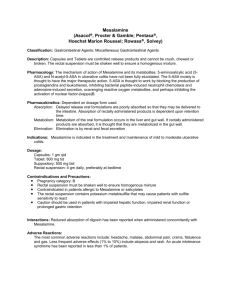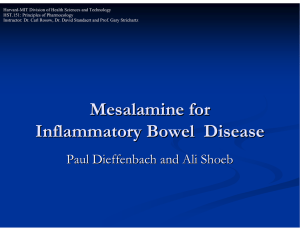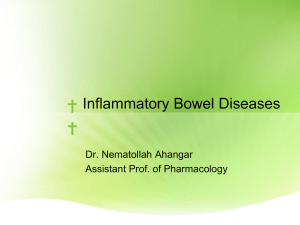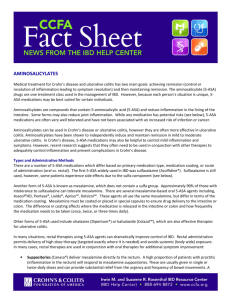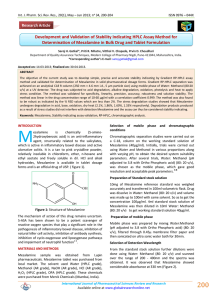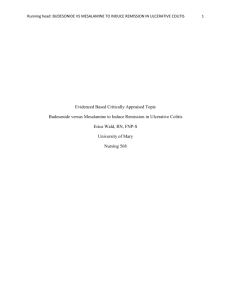Harvard-MIT Division of Health Sciences and Technology HST.151: Principles of Pharmocology
advertisement
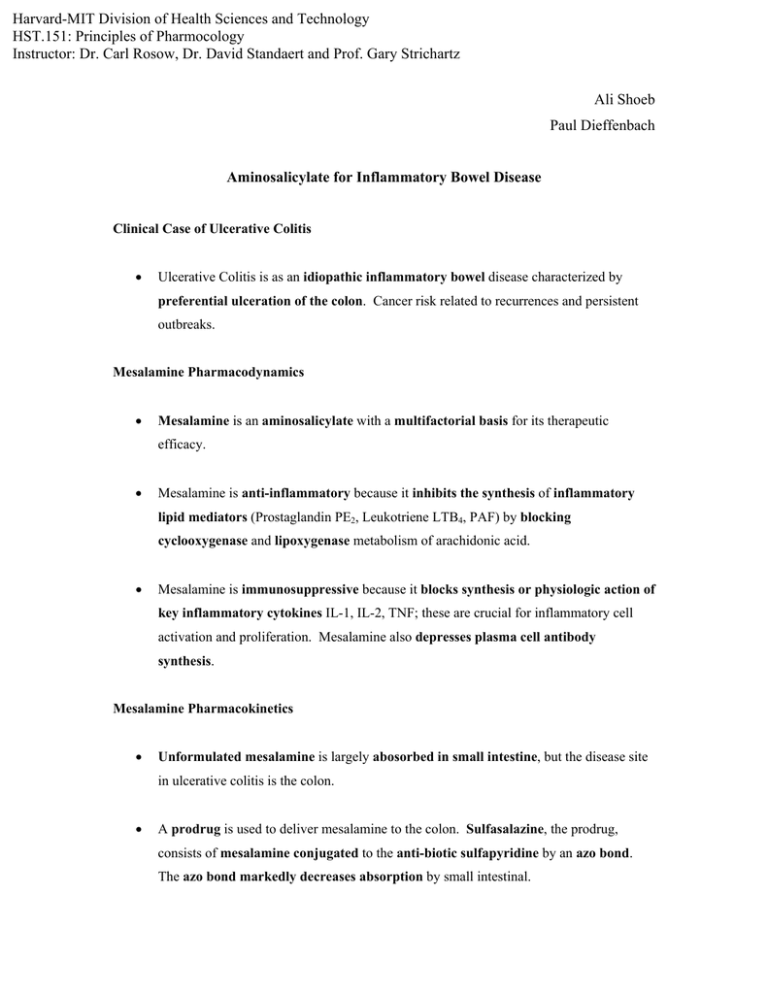
Harvard-MIT Division of Health Sciences and Technology HST.151: Principles of Pharmocology Instructor: Dr. Carl Rosow, Dr. David Standaert and Prof. Gary Strichartz Ali Shoeb Paul Dieffenbach Aminosalicylate for Inflammatory Bowel Disease Clinical Case of Ulcerative Colitis • Ulcerative Colitis is as an idiopathic inflammatory bowel disease characterized by preferential ulceration of the colon. Cancer risk related to recurrences and persistent outbreaks. Mesalamine Pharmacodynamics • Mesalamine is an aminosalicylate with a multifactorial basis for its therapeutic efficacy. • Mesalamine is anti-inflammatory because it inhibits the synthesis of inflammatory lipid mediators (Prostaglandin PE2, Leukotriene LTB4, PAF) by blocking cyclooxygenase and lipoxygenase metabolism of arachidonic acid. • Mesalamine is immunosuppressive because it blocks synthesis or physiologic action of key inflammatory cytokines IL-1, IL-2, TNF; these are crucial for inflammatory cell activation and proliferation. Mesalamine also depresses plasma cell antibody synthesis. Mesalamine Pharmacokinetics • Unformulated mesalamine is largely abosorbed in small intestine, but the disease site in ulcerative colitis is the colon. • A prodrug is used to deliver mesalamine to the colon. Sulfasalazine, the prodrug, consists of mesalamine conjugated to the anti-biotic sulfapyridine by an azo bond. The azo bond markedly decreases absorption by small intestinal. • The therapeutically effective moiety, mesalamine, is released from Sulfasalazine in the terminal ileum and colon because colonic bacteria cleave the azo bond using the bacterial enzyme azoreductase. • Sulfapyridine moiety is allergenic causing a symptomatic triad of rash, fever, and hepatic dysfunction. Adverse reactions are a function of sulfapyridine serum concentration (Css), which is inversely proportional to drug clearnace via hepatic Phase I and II metabolisim and renal execretion. CSS = ( Bioavailability * Dose ) / ( Interval Dose * Clearance) • 50% of caucasians and african-americans are “Slow Acetylators”. They have altered Phase II drug metabolism due to missing isoform of N-acetylation enzyme, NAT-2. Missing isoform decreases sulfapyridine clearance and increases its serum concentration leading to toxicity. Alternative Mesalamine Formulations • Alternative mesalamine formulations focus on colonic delivery of mesalamine without sulfapyridine conjugation. For example, Olsalazine is formed by conjugating two mesalamine molecules via an azo bond. Presence of azo bond requires colonic bacteria for cleavage, and ensures colonic mesalamine release. • Asacol packages mesalamine in a pH-sensitive coating. Coating dissolves only in the colonic setting where pH (~ 7) targeting mesalamine to colon. This is crucial for ulcerative colitis which preferentially affects colon. • Pentasa packages mesalamine in semi-permeable microgranules. Microgranules allow for slow release of mesalamine throughout intestinal tract. This effective for Crohn’s Disease which affects the entire intestinal tract; contrast with Ulcerative Colitis. **Big Ideas**: Mesalamine’s multifactorial basis for therapeutic efficacy; Prodrug for drug targeting and delivery; Altered drug metabolism phenotype increases risk for toxicity.
